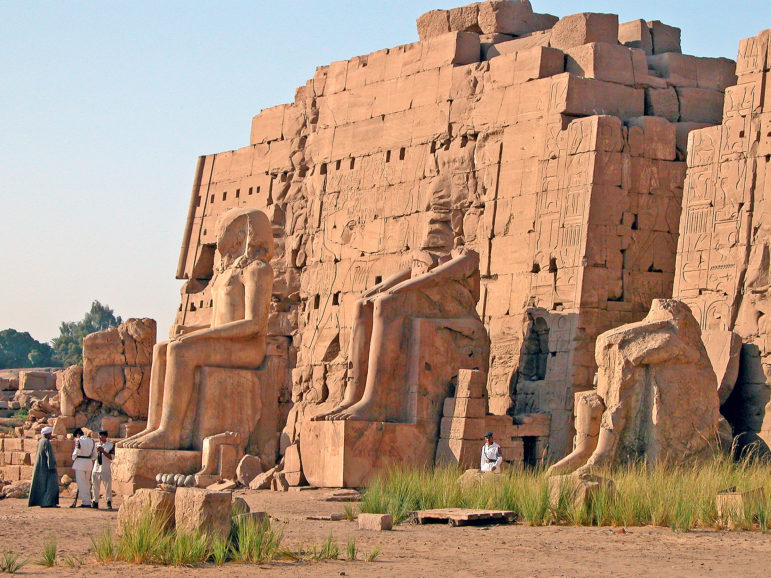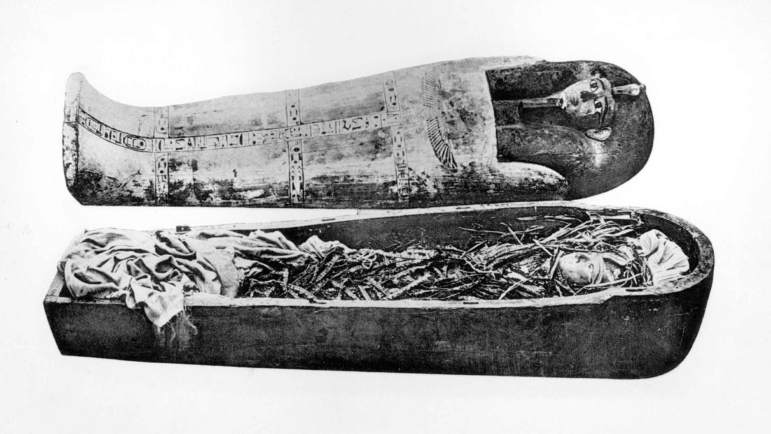TWH – “Frontiers in Medicine” reported on a CT scan examination of the mummy of Amenhotep I. That examination revealed a great deal about ancient Egyptian mummification rituals and practices. Prior invasive processes involved manually unwrapping the physical mummy. This non-invasive process leaves the mummy intact.
Who was Amenhotep I?
Amenhotep I, the second pharaoh of the 18th Dynasty, reigned from circa 1525 to 1504 B.C.E. After his death, ancient tomb robbers, broke into his tomb, damaging his mummy. In the 21st Dynasty (1070 to 945 B.C.E.), priests repaired and re-entombed the mummy of Amenhotep I. They noted their repairs in hieroglyphics on his coffin lid.

The white limestone colossus, representing Amenhotep I, was carved from a single block. The king is seated with his right hand closed and his left hand open, resting on his knees. Constructed by Hatshepsut (1505-1484 B.C.). Karnak Temple, Luxor, Egypt – Image credit: Dennis Jarvis – Amenhotep I, CC BY-SA 2.0
In 1881, researchers found mummies at Deir el-Bahari Royal Cache in Luxor, including that of Amenhotep I. Priests had wrapped his mummy in linen. They covered his mummy with red, yellow, and blue floral garlands. Not wanting to disturb its intricate coverings, researchers avoided invasive examinations.
As CT scans came into medical use, they offered a non-invasive way to examine Amenhotep’s mummy. The lead author of the “Frontiers in Medicine” article, Sahar Saleem is on the Medical Faculty of Cairo University.
A CT scan (computed tomography), also known as a CAT scan, is “an advanced form of X-ray that obtains hundreds of thin sections (slices) of the body and provides more detailed reconstructed images of soft tissues as well as bones.”
What does the mummy of Amenhotep I look like to the naked eye?
A head mask of “cartonnage” covers the head and shoulder areas. A cartonnage is defined as a material “consisting of linen or papyrus glued together in many thicknesses and usually coated with stucco.”

Coffin and mummy of Amenhotep I – Image credit: G. Elliot Smith (edited in GIMP) – Public Domain
On a separate wooden face mask, a temple painter had painted the face yellow. They also painted the eyebrows and the outline of the eyes black.
Inlaid stones form the eyes. In place of the pupil, a black obsidian crystal stares back. On the forehead, a funerary worker had inserted a separately carved cobra with inlaid stones.
The digital unwrapping
The CT scan produced a three-dimensional image of many layers. Researchers could now unwrap each layer of the digital image rather than the actual mummy.

Three-dimensional CT image of the digitally unwrapped face of the mummy Amenhotep I. (A) Three-dimensional CT image of the front of the face of Amenhotep I and (B) Three-dimensional CT image of the left profile of the face of Amenhotep I show an oval face with a narrow chin, small narrow nose flattened by the bandages, mildly protruding upper teeth, sunken eyes, collapsed cheeks, pierced lobule of the left ear, and few coiled hair locks. – Image credit: Saleem and Hawass – CC BY-SA 4.0
Amenhotep I had a narrow chin and nose with his upper teeth protruding mildly. His ears were small and his left ear was pierced. He had a few “coiled hair locks” on the back and sides of his head.
Researchers estimated that Amenhotep I died around the age of 35. They estimated that he stood 169 cm (5.5 ft ) tall. His teeth had mild attrition and all wisdom teeth were present. He had been circumcised. They found no evidence of the cause of death.
The ancient tomb robbers had decapitated the mummy, and had dislocated the right hand and left upper arm. The left hand is missing two fingers. They had disarticulated the right foot. The robbers had cut into the abdominal wall.
The brain and heart remained in the body. Embalmers had removed the other organs. Loose linen packing had replaced the missing organs. The right upper arm, the left lower leg, the penis, the right thigh, and the right calf have been individually wrapped. They had wrapped the fingers of the right hand with the hand. In a similar manner, they had wrapped the toes of the left foot with that foot.
Repairing a mummy
In the 21st Dynasty (1069 to 945 B.C.E.), priests repaired the mummy. They used a resin-soaked piece of linen to reattach the head to the body. They used another linen strip to cover the slash in the abdominal wall. First, however, they placed two amulets between the slash and the linen strip.
The priests placed the upper left arm next to the body, using pins through the bandages to hold it in place. They wrapped that left arm, not individually, but to the torso and right arm.
The disarticulated right foot received special treatment. The priests placed it on a wooden board. They wrapped the board and the foot together with linen. They fixed the board to the coffin using six nails.
Amulets
For the ancient Egyptians, amulets offered protection for the dead. The Egyptian “Book of the Dead” specified amulet type and placement. The power of the amulet lay in its color, material, and shape.
The amulets in Amenhotep’s mummy included the following shapes: beads, double-plume, Eye of Horus, heart scarab, snail-shell, papyrus scroll, scarab, serpent head, among others. Their size ranged from 5 mm to 45 mm (0.2 to 1.7 inches). Priests had also placed a beaded golden girdle or belt along the back of the pelvic area.
Mummification techniques changed over time
Mummification formed a vital part of ancient Egyptian religion for the 30 centuries of its existence. It changed over those centuries. In the late 17th and early 18th Dynasties during Amenhotep I’s time, priests did not remove the brain during mummification. Amenhotep I’s mummy kept its brain.
The technique to wrap the mummy also changed over time. In the New Kingdom (1539 to 1292 B.C.E) which the reign of Amenhotep I was within, mummification became more elaborate. Priests would wrap limbs individually. After wrapping each limb, they would then wrap the entire body. During that wrapping, the priests would enact a ritual with incantations. They would place the amulets as part of this ritual.
The mummy of Amenhotep I had composite linen wrapping from his initial burial and from the later repair. This composite wrapping would explain why some limbs are individually wrapped and others are not.
It could also explain differences in arm position. One arm lies at the side of the mummy. The other is crossed over his chest. In the 18th Dynasty, mummies frequently had arms crossed across their chests. In the repairs of the 21st dynasty, priests had placed the damaged left arm beside the torso.
Mummification was not a secular process. A mummy, a magical object, exists as the physical remains of a series of rituals. Its power extends over the centuries. EurekAlert!, the news arm of the American Association for the Advancement of Science reported that the facemask of the mummy of Amenhotep I had become the icon of the “Royal Golden Mummy Parade” in Cairo in 2021.
The Wild Hunt is not responsible for links to external content.
To join a conversation on this post:
Visit our The Wild Hunt subreddit! Point your favorite browser to https://www.reddit.com/r/The_Wild_Hunt_News/, then click “JOIN”. Make sure to click the bell, too, to be notified of new articles posted to our subreddit.